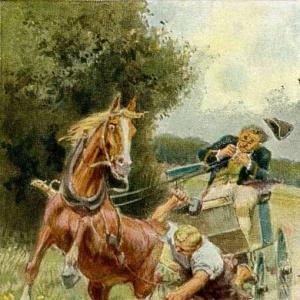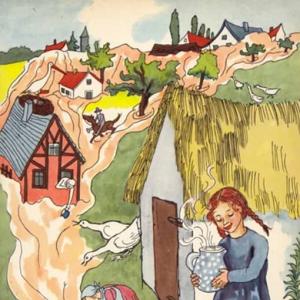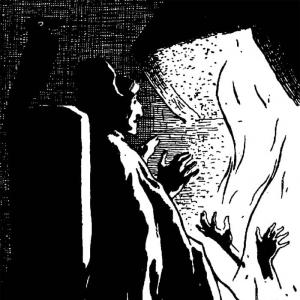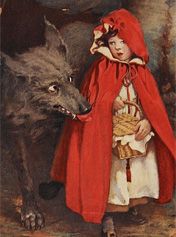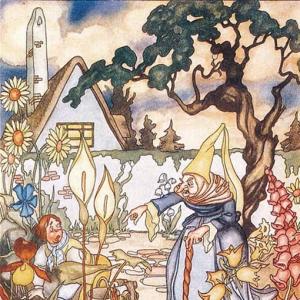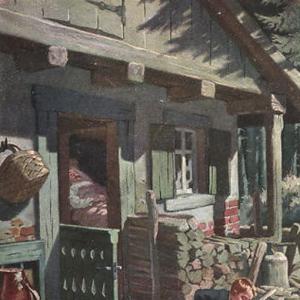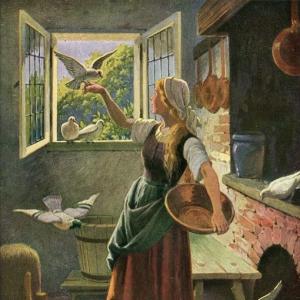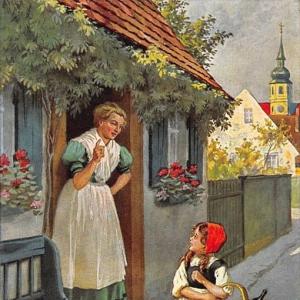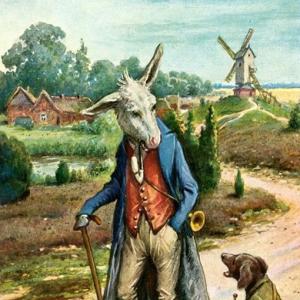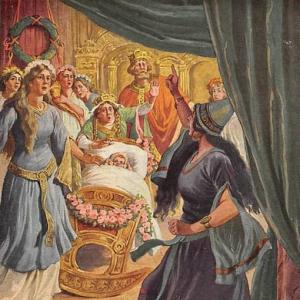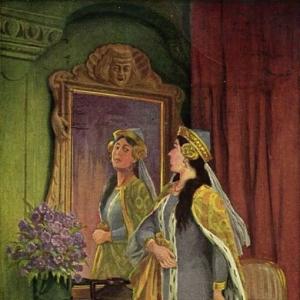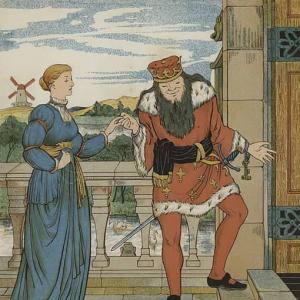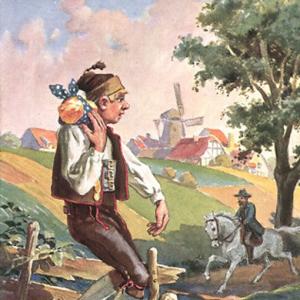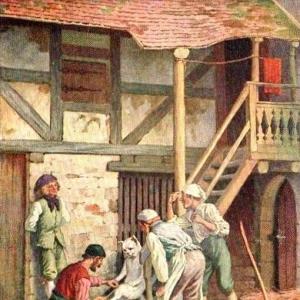Reading time: 8 min
A tailor and a goldsmith were travelling together, and one evening when the sun had sunk behind the mountains, they heard the sound of distant music, which became more and more distinct. It sounded strange, but so pleasant that they forgot all their weariness and stepped quickly onwards. The moon had already arisen when they reached a hill on which they saw a crowd of little men and women, who had taken each other’s hands, and were whirling round in the dance with the greatest pleasure and delight. They sang to it most charmingly, and that was the music which the travellers had heard. In the midst of them sat an old man who was rather taller than the rest. He wore a parti-coloured coat, and his iron-grey beard hung down over his breast. The two remained standing full of astonishment, and watched the dance. The old man made a sign that they should enter, and the little folks willingly opened their circle. The goldsmith, who had a hump, and like all hunchbacks was brave enough, stepped in. The tailor felt a little afraid at first, and held back, but when he saw how merrily all was going, he plucked up his courage, and followed. The circle closed again directly, and the little folks went on singing and dancing with the wildest leaps. The old man, however, took a large knife which hung to his girdle, whetted it, and when it was sufficiently sharpened, he looked round at the strangers. They were terrified, but they had not much time for reflection, for the old man seized the goldsmith and with the greatest speed, shaved the hair of his head clean off, and then the same thing happened to the tailor. But their fear left them when, after he had finished his work, the old man clapped them both on the shoulder in a friendly manner, as much as to say, they had behaved well to let all that be done to them willingly, and without any struggle. He pointed with his finger to a heap of coals which lay at one side, and signified to the travellers by his gestures that they were to fill their pockets with them. Both of them obeyed, although they did not know of what use the coals would be to them, and then they went on their way to seek a shelter for the night. When they had got into the valley, the clock of the neighbouring monastery struck twelve, and the song ceased. In a moment all had vanished, and the hill lay in solitude in the moonlight.
The two travellers found an inn, and covered themselves up on their straw-beds with their coats, but in their weariness forgot to take the coals out of them before doing so. A heavy weight on their limbs awakened them earlier than usual. They felt in the pockets, and could not believe their eyes when they saw that they were not filled with coals, but with pure gold; happily, too, the hair of their heads and beards was there again as thick as ever.
They had now become rich folks, but the goldsmith, who, in accordance with his greedy disposition, had filled his pockets better, was as rich again as the tailor. A greedy man, even if he has much, still wishes to have more, so the goldsmith proposed to the tailor that they should wait another day, and go out again in the evening in order to bring back still greater treasures from the old man on the hill. The tailor refused, and said, „I have enough and am content. Now I shall be a master, and marry my dear object (for so he called his sweetheart), and I am a happy man.“ But he stayed another day to please him. In the evening the goldsmith hung a couple of bags over his shoulders that he might be able to stow away a great deal, and took the road to the hill. He found, as on the night before, the little folks at their singing and dancing, and the old man again shaved him clean, and signed to him to take some coal away with him. He was not slow about sticking as much into his bags as would go, went back quite delighted, and covered himself over with his coat. „Even if the gold does weigh heavily,“ said he, „I will gladly bear that,“ and at last he fell asleep with the sweet anticipation of waking in the morning an enormously rich man.
When he opened his eyes, he got up in haste to examine his pockets, but how amazed he was when he drew nothing out of them but black coals, and that howsoever often he put his hands in them. „The gold I got the night before is still there for me,“ thought he, and went and brought it out, but how shocked he was when he saw that it likewise had again turned into coal. He smote his forehead with his dusty black hand, and then he felt that his whole head was bald and smooth, as was also the place where his beard should have been. But his misfortunes were not yet over. He now remarked for the first time that in addition to the hump on his back, a second, just as large, had grown in front on his breast. Then he recognized the punishment of his greediness, and began to weep aloud. The good tailor, who was wakened by this, comforted the unhappy fellow as well as he could, and said, „Thou hast been my comrade in my travelling time; thou shalt stay with me and share in my wealth.“ He kept his word, but the poor goldsmith was obliged to carry the two humps as long as he lived, and to cover his bald head with a cap.
 Learn languages. Double-tap on a word.Learn languages in context with Childstories.org and Deepl.com.
Learn languages. Double-tap on a word.Learn languages in context with Childstories.org and Deepl.com.Backgrounds
Interpretations
Adaptions
Summary
Linguistics
„The Little Folks‘ Presents“ is a German fairy tale collected by the Brothers Grimm, Jacob and Wilhelm Grimm, in their renowned collection titled „Kinder- und Hausmärchen“ (Children’s and Household Tales) first published in 1812. The Brothers Grimm were German academics, linguists, cultural researchers, and authors who gathered and published numerous folktales, many of which have become classic fairy tales enjoyed by generations of readers.
The Brothers Grimm collected these stories as part of their mission to preserve traditional German folklore, which they believed was important for understanding the cultural identity and history of the German-speaking people. They sourced their tales from various contributors, including peasants, friends, and other storytellers. „The Little Folks‘ Presents,“ like many other Grimm fairy tales, contains magical elements, moral lessons, and memorable characters, which have contributed to its enduring popularity.
The story is part of a broader tradition of European folklore that often features supernatural beings such as fairies, elves, and dwarfs. These tales frequently include moral lessons and explore themes such as greed, contentment, and friendship. The Grimm brothers‘ collection, which has been translated into numerous languages and adapted into various forms of media, has played a significant role in popularizing these traditional stories and preserving them for future generations.
„The Little Folks‘ Presents“ offers several interpretations and moral lessons. Some of the key themes and interpretations are as follows:
The consequences of greed: The goldsmith’s insatiable desire for wealth leads to his downfall. His greediness not only results in the loss of his newfound fortune but also the addition of a second hump and a bald head. This story teaches readers that giving in to greed can have negative consequences and that one should be content with what they have.
The value of contentment: In contrast to the goldsmith, the tailor is satisfied with the wealth he initially acquires and does not seek more. His contentment and appreciation for his good fortune ultimately lead to a happier life. The story encourages readers to find happiness in what they have and not constantly chase after more.
The power of friendship and compassion: Despite the goldsmith’s flaws, the tailor remains loyal to him, even offering to share his wealth. The tailor’s kindness and compassion demonstrate the importance of helping others in need and maintaining strong friendships.
The supernatural and the unexplained: The story features magical elements, such as the little folks and the transformation of coal into gold. These supernatural aspects serve to captivate the reader’s imagination and add a sense of wonder and mystery to the tale. They may also symbolize the idea that there are forces beyond human comprehension that can influence one’s life.
The consequences of one’s actions: The tale illustrates that actions have consequences, as seen with the goldsmith’s punishment. It teaches readers to be mindful of their choices and understand that they may have to face the consequences of their actions, whether good or bad.
„The Little Folks‘ Presents“ (also known as „The Elves“ or „The Shoemaker and the Elves“) from Brothers Grimm is a popular and enduring fairy tale that has been adapted into various forms of media over the years. Here are some notable adaptations:
The Elves and the Shoemaker (Disney’s Silly Symphony, 1935) – This animated short film by Disney tells the story of the shoemaker and the elves in a musical format.
The Elves and the Shoemaker (Ballet, 1957) – This ballet adaptation by choreographer Frederick Ashton was first performed by the Royal Ballet in 1957 and has since been performed by many ballet companies around the world.
The Shoemaker and the Elves (TV movie, 1986) – This TV movie adaptation features actors as the shoemaker and his wife, as well as puppets as the elves.
The Shoemaker and the Elves (Children’s book, 2003) – This children’s book adaptation by Gennady Spirin features intricate and detailed illustrations of the shoemaker, his wife, and the elves.
The Elves and the Shoemaker (Musical, 2013) – This musical adaptation by Stephen M. Smyth and Jo Noel-Hartley was first performed in 2013 and features catchy songs and dance numbers.
The Elves and the Shoemaker (Interactive storybook app, 2015) – This interactive storybook app by Nosy Crow allows children to explore the story of the shoemaker and the elves through touch and sound.
The Elf on the Shelf (Children’s book, 2005) – While not a direct adaptation of „The Little Folks‘ Presents,“ this popular children’s book features a similar concept of magical elves who help a family during the holiday season.
These are just a few examples of the many adaptations of „The Little Folks‘ Presents“ that have been created over the years. The enduring popularity of this fairy tale speaks to its universal themes and timeless appeal.
„The Little Folks‘ Presents“ is a fairy tale by the Brothers Grimm about a tailor and a goldsmith who stumble upon a group of little magical beings dancing and singing one night. Among them is an old man with a long beard, who invites the two men to join the dance. The old man then shaves their heads and instructs them to fill their pockets with coal from a nearby heap.
Upon leaving, the two travelers discover that the coal has turned into gold, and their hair has grown back. The goldsmith, driven by greed, convinces the tailor to stay another day so he can collect more treasure. The tailor, content with his newfound wealth, agrees. That night, the goldsmith returns to the hill, gets shaved again, and fills his bags with coal. However, when he wakes up the next morning, he finds that the coal hasn’t transformed into gold this time, and he has now grown a second hump on his chest.
Realizing his greed has led to this punishment, the goldsmith despairs. The kind-hearted tailor comforts him, promising to share his wealth with his friend. The goldsmith lives the rest of his life with two humps and a bald head, having learned a valuable lesson about the consequences of greed.
The fairy tale „The Little Folks‘ Presents“ by the Brothers Grimm presents a rich text for linguistic analysis. Here, we’ll explore several aspects of the language used, including diction, syntax, figurative language, and thematic elements present in the tale.
Diction and Vocabulary
Archaic and Formal Language: The tale uses terms such as „parti-coloured“ and „iron-grey,“ which are reminiscent of older English usage, given the Brothers Grimm’s period and style. The use of „thee,“ „thou,“ and „thy“ contributes to a formal and traditional tone.
Descriptive Adjectives: The narrative is rich with adjectives that create vivid imagery, such as „whirling round in the dance,“ „wildest leaps,“ and „pure gold. “ These adjectives enhance the fantastical and magical quality of the tale.
Conversational Tone: Although the overall language is formal, the direct speech between characters, such as „I have enough and am content,“ provides a conversational tone, making the characters relatable.
Syntax
Complex Sentences: The tale frequently employs complex sentences with multiple clauses, such as „When they had got into the valley, the clock of the neighbouring monastery struck twelve, and the song ceased. “ This adds depth to the narrative and reflects a formal storytelling style.
Balanced Structure: Phrases are often balanced, especially in descriptions and actions to maintain rhythm, such as „The goldsmith, who had a hump, and like all hunchbacks was brave enough. “
Figurative Language
Symbolism: The transformation of coals into gold and vice versa symbolically represents moral values. Gold symbolizes contentment and righteous living, while coal represents greed and discontent.
Imagery: Vivid images are crafted through the description of the dancing little folks, the moonlit night, and the morning revelations of gold and coal. This imagery brings the magical setting to life.
Irony: The goldsmith’s misfortunes highlight the irony. His greed leads to punishment, while the contented tailor gains wealth and happiness, subverting the expectation of wealth leading to happiness.
Thematic Elements
Greed vs. Contentment: A primary theme is the contrast between greed and contentment. The tailor’s contentment with modest wealth and the goldsmith’s incessant greed illustrate moral lessons about satisfaction and the consequences of avarice.
Transformation and Reward: The tale explores transformation as a form of reward and punishment. The magical transformation of coals to gold – and back again for the greedy – reflects the idea that moral behavior determines one’s fortune.
Friendship and Loyalty: Despite the goldsmith’s greed, the tailor’s offer to share his wealth with his friend emphasizes the values of loyalty and compassion.
In sum, „The Little Folks‘ Presents“ utilizes linguistic elements to create a rich tapestry of narrative infused with moral lessons. The choice of language, sentence structures, and literary devices collectively enhance the fantastical and timeless quality of this Brothers Grimm fairy tale.
Information for scientific analysis
Fairy tale statistics | Value |
|---|---|
| Number | KHM 182 |
| Aarne-Thompson-Uther-Index | ATU Typ 503 |
| Translations | DE, EN, DA, ES, FR, PT, IT, JA, NL, PL, RO, RO, RU, TR, VI, ZH |
| Readability Index by Björnsson | 38.8 |
| Flesch-Reading-Ease Index | 71.7 |
| Flesch–Kincaid Grade-Level | 9.7 |
| Gunning Fog Index | 12.6 |
| Coleman–Liau Index | 8.6 |
| SMOG Index | 10.1 |
| Automated Readability Index | 11 |
| Character Count | 5.210 |
| Letter Count | 4.073 |
| Sentence Count | 38 |
| Word Count | 984 |
| Average Words per Sentence | 25,89 |
| Words with more than 6 letters | 127 |
| Percentage of long words | 12.9% |
| Number of Syllables | 1.266 |
| Average Syllables per Word | 1,29 |
| Words with three Syllables | 55 |
| Percentage Words with three Syllables | 5.6% |
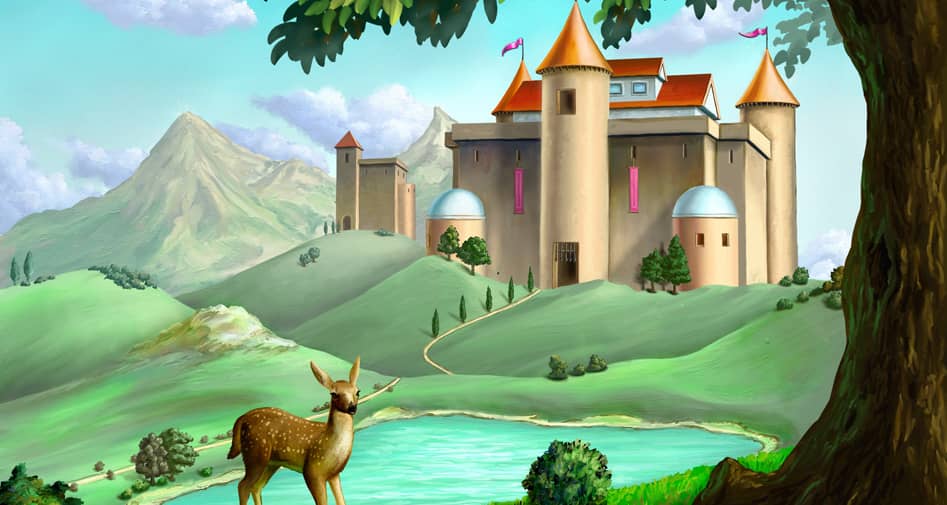
 Facebook
Facebook  Whatsapp
Whatsapp  Messenger
Messenger  Telegram
Telegram Reddit
Reddit